Home

Basic Knots
Advanced Knotwork
Line Treatments
Analysis
Alternative Grids
Further Topics
Sources
Sample Grids
|
Home |
 |
Basic Knots |
Advanced Knotwork |
Line Treatments |
Analysis |
||||
|
Alternative Grids |
Further Topics |
Sources |
Sample Grids |
The most basic rule of interlacing is: "First under then over then under then..."
Some early documented construction techniques (see [BainG]) involved drawing lines, then creating ribbon-like bands around these lines, and then erasing the interlaced areas. Later construction techniques (see [van Stone], [Sherb], and [BainI]) involve generating a grid of cells using points laid out like "dice 5", and only drawing the lines needed, with little or no erasing required. From evidence on the manuscripts themselves (see [Hull] for details) this appears similar to the actual techniques used by the orignal Insular Celtic scribes.
 |
One "cell". |
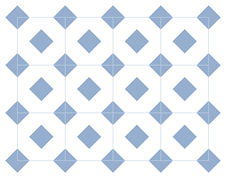 |
These cells are repeated and grouped to give a "grid" (in this case of 3 cells by 2 cells) of dots, circles, or diamonds. That is, the dots, small circles or diamond shapes are drawn to provide guidelines for the knotwork bands. The following table provides pros and cons for using the different pattern layout variations: |
PROS: |
CONS: | |
Dots: |
Quick and authentic, little or no erasing required |
Harder to keep constant band with |
Small Circles: |
Easier to keep constant band width, and easier to hand draw |
Some erasing may be required in corners and along walls |
Diamonds: |
Most accurate and consistent band width |
Hard to hand draw (but easy on the computer), and will always require some erasing |
Bands are drawn at 45° to the original grid, between but not touching the dots. If bubbles (small circles) or diamonds are used, then the edges touch the edges of the circles/diamonds. The bands "bounce" or "turn" off the edges and corners of the grid (referred to as the "walls" in this tutorial). Please see the example below:
 |
1. Build grid (example uses 3 cells by 4 cells and uses diamond shapes to mark the centers of the grid points). |
 |
2. Draw 2 parallel lines starting at the edges of the circles, diamonds (or just off the dots), not the centers. Think of bands of ribbon placed between pegs. |
 |
3. Now draw the perpendicular bands on either end... |
 |
4. ...and bands running "under" the middle of the original band... |
 |
5. ...then continue with all bands until you run into a "wall" or corner. |
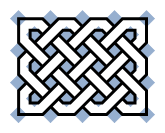 |
6. For now, just "square off" the corners and wall turns (we'll get into curving these later). |
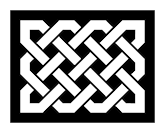 |
7. Finally, fill in the background with black to cover the dot/circle/diamond layout markers. |
Please attempt this interlace on your own. Download one of the the sample grids, and work with it as is, or print and use behind plain paper as calligraphy guides are used.
Most examples from actual documents use curved lines, not the angular corners we've done so far. Doing curves requires thinking ahead in the corners and walls. To get a smooth curve into the corner and against walls, you need to start back from the edge of the line that will hit the wall. Then smoothly curve the lines into the corners and walls. Try to keep the band a constant width, even though you may overrun the circles (or diamonds) in the centers of the cells. You'll see many examples of curved knotwork designs in the remainder of these instructions.
A row of cells can be used to form a border. The simplest version is one cell wide. The example below shows the grid, a section of the plait, and the same section filled in:
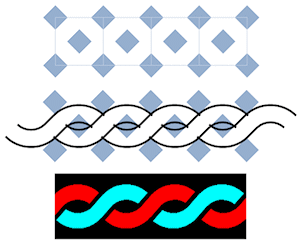
As the colors show, it uses two bands to form the border, which repeats every two cells.
A border "1 and 1/2" cells wide uses three bands, as shown by the colored example below:
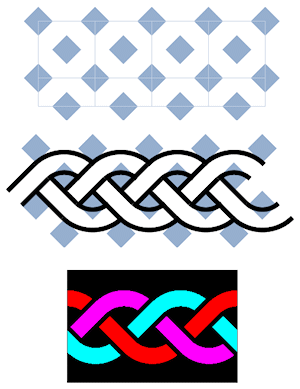
This type of border is uses as a basis for a number of Celtic knots, as will be seen in some of the examples. It repeats every three cells.
A 2-cell wide border (often used in Celtic work) is initially four separate bands, repeating every four cells:
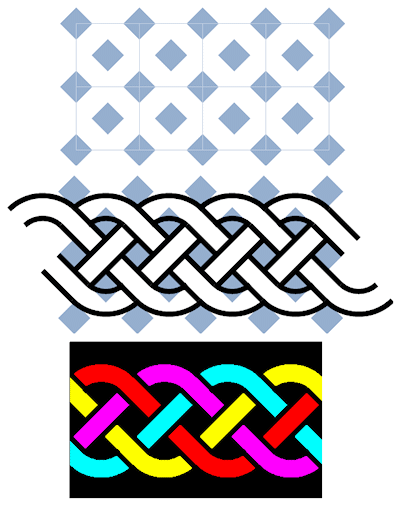
Please note that all these plaits are constructed in the same way as the simple interlacing example, except they have no "corners", just "walls".